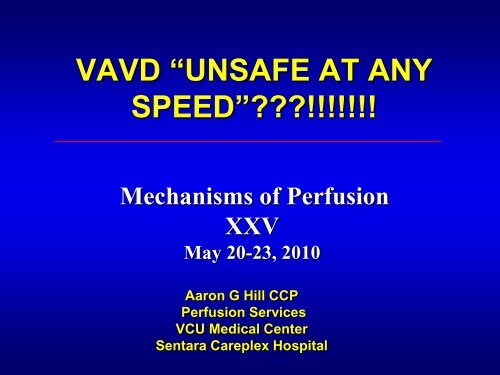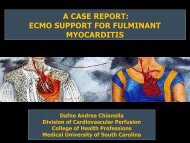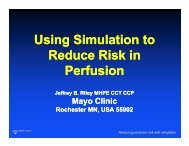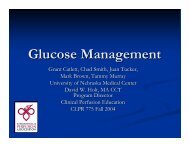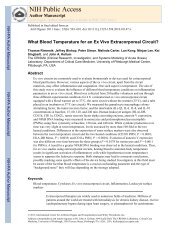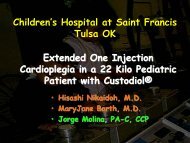vavd - Perfusion.com
vavd - Perfusion.com
vavd - Perfusion.com
You also want an ePaper? Increase the reach of your titles
YUMPU automatically turns print PDFs into web optimized ePapers that Google loves.
VAVD “UNSAFE AT ANY<br />
SPEED”???!!!!!!!<br />
Mechanisms of <strong>Perfusion</strong><br />
XXV<br />
May 20-23, 2010<br />
Aaron G Hill CCP<br />
<strong>Perfusion</strong> Services<br />
VCU Medical Center<br />
Sentara Careplex Hospital
Ron Diane Joe<br />
Course Description<br />
Ron Diane Joe<br />
MECHANISMS OF PERFUSION<br />
XXV
Early History of CPB<br />
• April 5, 1951 - Dr. Dennis of the Univ of<br />
Minnesota was the first to use a heartlung<br />
machine clinically to permit<br />
intracardiac surgery. Both patients died<br />
in the operating room. The first was due<br />
to an erroneous diagnosis, the second<br />
patient, after an ASD repair, died of a<br />
massive air embolism.<br />
• May 1953 - Dr. John Gibbon performed a<br />
successful ASD closure on an 18 yr old<br />
female. The only 1 of 6 patients to<br />
survive.<br />
D
Three Universal Accident<br />
Ingredients<br />
(1) All human beings, regardless of their<br />
skills, abilities, and specialist knowledge,<br />
make fallible decisions and <strong>com</strong>mit unsafe<br />
acts. The human propensity for <strong>com</strong>mitting<br />
errors and violating safety procedures can<br />
be moderated by selection, training, welldesigned<br />
equipment, and good<br />
management, but it can never be entirely<br />
eliminated.<br />
James Reason
The best safety device in any<br />
aircraft<br />
is a well trained crew
Three Universal Accident<br />
Ingredients<br />
(2) No matter how well designed, constructed, operated,<br />
and maintained they all may be, all man-made systems<br />
possess latent failures in some degree. These failures<br />
are analogous to resident pathogens in the human body<br />
that <strong>com</strong>bine with local triggering factors (i.e., life<br />
stresses, toxic chemicals etc…) to over<strong>com</strong>e the<br />
immune system. Like cancer and cardiovascular<br />
disease, disasters in well-defended systems do not arise<br />
from single causes. They occur because of the adverse<br />
conjunction of several factors, each necessary, but none<br />
sufficient to breach the defenses.<br />
James Reason
Three Universal Accident<br />
Ingredients<br />
(3) All human endeavors involve some<br />
measure of risk. In many cases, the local<br />
hazards are well understood and can be<br />
guarded against by a variety of technical<br />
or procedural counter-measures. But no<br />
one can foresee all the possible accident<br />
scenarios, so there will always be chinks<br />
in this protective armor.<br />
James Reason
Aviation Checklists<br />
Northwest Airlines<br />
Flight 255<br />
NTSB Conclusions:<br />
- Failure to use the taxi checklist<br />
to ensure that the flaps and slats<br />
were extended for take-off<br />
- Contributing to the accident was<br />
the malfunction of the take-off<br />
warning system.
A Retrospective Study on <strong>Perfusion</strong><br />
Incidents and Safety Devices<br />
90<br />
80<br />
70<br />
60<br />
50<br />
40<br />
30<br />
20<br />
10<br />
0<br />
KAVD VAVD MIS VAD HILP<br />
% Usage<br />
Mejak et al<br />
<strong>Perfusion</strong> 2000<br />
15: 51-61
Venoarterial Air Embolus: A Complication of<br />
Vacuum-Assisted Venous Drainage<br />
• 33 yr F scheduled for elective repair of secundum ASD.<br />
• Minimally invasive approach. VAVD for first time.<br />
• Upon initiation of CPB, air passed retrograde up venous<br />
line due to pressurized venous reservoir.<br />
• Surgical case proceeded as planned. XCL 38 min.<br />
• Post op left hemiparesis, mental obtundation, left visual<br />
disturb. Hyperbaric oxygenation.<br />
• Discharged on POD #4 with normal neurologic finding.<br />
Davila et al<br />
Ann Thorac Surg 2001<br />
71: 1369-71
VAVD<br />
• Wall Vacuum Source<br />
• Negative Pressure Regulator<br />
• Sealed Cardiotomy Reservoir<br />
• Safety/Monitoring
VAVD<br />
Monitoring<br />
• Wall suction in inches of Hg<br />
• Line suction in mmHg<br />
• Venous line
VAVD<br />
• Wall Source/Regulator<br />
• Negative Pressure: 15-20 inches of Hg<br />
• @25.4mm/inch equal to 400-500mmHg<br />
• Two Pressure Gauges
VAVD<br />
• Sealed Cardiotomy<br />
• Jostra<br />
• Cobe<br />
• Medtronic<br />
• Terumo
VAVD<br />
Safety<br />
• Positive relief valve<br />
• Negative relief valve<br />
• Empty prime bag<br />
• Checklist
VAVD<br />
VAVD Components and Pricing...<br />
• Flow Regulators:<br />
Price- $285.00 - $2000 / per unit<br />
• VAVD Disposable Kit:<br />
» (relief valves, vapor trap, assembled tubing)<br />
Price- $32.00 - $35.00 / per pack<br />
Prices reflected may decrease with volume
VAVD<br />
Bypass Initiation<br />
• Start Arterial Pump<br />
• Open Venous Line<br />
• Clamp Tubing to Apply Suction<br />
• Communicate with Surgeon
VAVD<br />
Checklist<br />
• VAVD relief valve on reservoir<br />
• VAVD empty bag on reservoir<br />
• VAVD vapor trap attached<br />
• VAVD vacuum checked<br />
• VAVD transducer zeroed
VAVD<br />
Applications<br />
• Heartport<br />
• Minimal Invasive Valve<br />
• Low Hematocrit
VAVD<br />
Concerns...<br />
• Venous Congestion<br />
• Gaseous Microemboli<br />
• SCADS<br />
• Air Embolism<br />
• Implosion
VAVD<br />
Research Objective...<br />
• Blood transfusion rate using VAVD<br />
• Compare VAVD vs. conventional drainage<br />
transfusion rates<br />
• To determine if preliminary VAVD data is<br />
clinically significant to initiate prospective<br />
randomized study
CHECKLIST OBJECTIVES<br />
• Aid recall<br />
• Dictate duties<br />
• Standard foundation<br />
• Convenient, sequential framework<br />
• Mutual supervision<br />
• Quality control<br />
• Promote positive attitude<br />
• Enhance team concept<br />
from NASA
Checklists<br />
• Preop<br />
• Setup<br />
• Prebypass<br />
• Bypass<br />
• Return To Bypass<br />
• Equipment<br />
• Charges
VAVD<br />
Benefits of Reduced Prime...<br />
• Increased Hematocrit<br />
• Increased Colloid Osmotic Pressure<br />
• Increased coagulation factor concentration<br />
• Reduce usage of blood products?
VAVD<br />
Faifax Hospital Adult CPB<br />
Circuit Protocol<br />
• Patients 55 kg and under:<br />
3/8” venous line, Terumo SX-10<br />
• For 56-70 kg:<br />
3/8” venous line, Terumo SX-18<br />
• For 71 kg and above:<br />
1/2” venous line, Terumo SX-18
VAVD<br />
Faifax Hospital Cell Saver<br />
Protocol...<br />
Cardiotomy Suction Setup<br />
• All valves<br />
• Re-Operations<br />
• All Aortic Aneurysms<br />
• LVAD implantation<br />
• HCT under 32%<br />
• Other conditions (Known bleeding history,<br />
Jehovah’s Witness, Renal Dysfunction)
THE QUESTION OF COST<br />
• 1986 PERFUSION SURVEY INJURY OR<br />
DEATH 1/4000 CASES<br />
• ASSUME 250 CASES/YEAR .06/YR<br />
• SUIT COST $ 2,000,000 SETTLE<br />
• SPEND $ 120,000/YR $480 / PROC<br />
• OR BE SEEN AS NEGLIGENT
THE QUESTION OF COST<br />
• The cost of a particular technology can be<br />
balanced against the probable cost of<br />
losing a single lawsuit.<br />
• Calculate the probability of an accident &<br />
multiply it by the cost of the accident.<br />
• If the result is greater than the cost of<br />
preventing the accident, negligence is<br />
automatically assumed!!!!!!!!
VAVD<br />
Faifax Hospital 1998<br />
Blood Component Cost...<br />
• Packed Red Blood Cells: $212.50 / unit<br />
• Fresh Frozen Plasma: $48.50 / unit<br />
• Single Donor Platelets: $914.00 / unit<br />
• Cryoprecipitate: $ 49.00 / unit
VAVD<br />
Patient Demographics...<br />
150 consecutive cases<br />
• 111 males / 39 females<br />
• Average age- 61 years<br />
(high- 86 years, low- 13 years)<br />
• Average wt.- 79.7 kg<br />
(high- 134 kg, low- 31 kg)<br />
• Average B.S.A.- 2.05
Hematocrit Profile<br />
VAVD<br />
Patient Demographics...<br />
• Baseline HCT (pre-CPB)- 37.3%<br />
• On bypass HCT (before CDPG)- 28.8%<br />
(net dilutional drop- 22.7%)<br />
• Lowest HCT on CPB- 26.4%<br />
• Last HCT in O.R.- 31.8%
Case Type<br />
3.3%<br />
8.6%<br />
8.1%<br />
80%<br />
CABG<br />
Valve<br />
Redo<br />
Other
Pump Prime<br />
2000<br />
1800<br />
1758 cc<br />
1658 cc<br />
1600<br />
1400<br />
1200<br />
1000<br />
800<br />
1.32<br />
1.12<br />
1258 cc<br />
0.95<br />
Pump Prime<br />
PRBC<br />
600<br />
400<br />
200<br />
0<br />
Closed<br />
System<br />
Open<br />
System<br />
VAVD
Transfusion Rate<br />
3<br />
2.5<br />
2<br />
1.5<br />
Total Products<br />
PRBC<br />
1<br />
0.5<br />
0<br />
Closed<br />
System<br />
Open<br />
System<br />
VAVD
Survival (%)<br />
Effect of Transfusion on Long-term Survival<br />
100<br />
80<br />
60<br />
No Tx<br />
1 Unit<br />
2 Units<br />
3-5 Units<br />
40<br />
> 6 Units<br />
20<br />
N=10,289<br />
0<br />
0 1 2 3 4 5 6 7 8 9 10<br />
Koch CG et al Ann Thorac Surg 2006;81:1650-7
Prevention<br />
Errors can be moderated by:<br />
‣Good training<br />
•Continuing education<br />
•Wet-labs/emergency drills<br />
‣Appropriate procedures<br />
•Checklists<br />
•Protocols<br />
•Adoption of new techniques<br />
‣Well-designed human-machine interface<br />
‣Identifying potential “latent” error
<strong>Perfusion</strong>ist phases<br />
• Phase I: beginning (pts 1- 10)<br />
– Anxiety, stress, high interest<br />
• Phase II: middle (pts 11- ?)<br />
– Novelty is gone, “hey, this isn’t so tough”<br />
• Phase III: Maturity<br />
– Appropriately vigilant, aware of the<br />
unpredictable nature of high tech medicine<br />
Devn Cornish
<strong>Perfusion</strong> Accidents and Near<br />
Misses<br />
Summary<br />
• Safety is an attitude<br />
• Attention to detail<br />
• Commitment to excellence<br />
• Communication<br />
• Teamwork
--------------<br />
<strong>Perfusion</strong>


